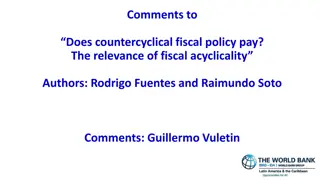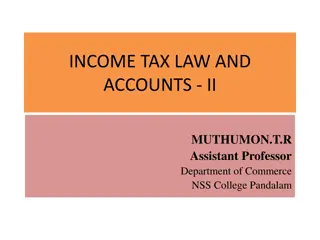Basel III Countercyclical Capital Buffer
Basel III introduces the Countercyclical Capital Buffer to address systemic risks in the banking sector. National authorities can adjust the buffer based on excess credit growth, ensuring banks have sufficient capital to withstand future losses. The buffer ranges from 0% to 2.5% of risk-weighted assets and is determined by deviations in the Credit-to-GDP ratio compared to its long-term trend.
Uploaded on Feb 25, 2025 | 0 Views
Download Presentation

Please find below an Image/Link to download the presentation.
The content on the website is provided AS IS for your information and personal use only. It may not be sold, licensed, or shared on other websites without obtaining consent from the author.If you encounter any issues during the download, it is possible that the publisher has removed the file from their server.
You are allowed to download the files provided on this website for personal or commercial use, subject to the condition that they are used lawfully. All files are the property of their respective owners.
The content on the website is provided AS IS for your information and personal use only. It may not be sold, licensed, or shared on other websites without obtaining consent from the author.
E N D
Presentation Transcript
Basel III Countercyclical Capital buffer
Countercyclical buffer The countercyclical buffer aims to ensure that banking sector capital requirements take account of the macro-financial environment in which banks operate. It will be deployed by national jurisdictions when excess aggregate credit growth is judged to be associated with a build-up of system-wide risk to ensure the banking system has a buffer of capital to protect it against future potential losses.
Countercyclical buffer This focus on excess aggregate credit growth means that jurisdictions are likely to only need to deploy the buffer on an infrequent basis. The buffer for internationally-active banks will be a weighted average of the buffers deployed across all the jurisdictions to which it has credit exposures. This means that they will likely find themselves subject to a small buffer on a more frequent basis, since credit cycles are not always highly correlated across jurisdictions.
Countercyclical buffer (Contd) National countercyclical buffer requirements Each Basel Committee member jurisdiction will identify an authority with the responsibility to make decisions on the size of the countercyclical capital buffer. If the relevant national authority judges a period of excess credit growth to be leading to the build up of system-wide risk, they will consider, together with any other macroprudential tools at their disposal, putting in place a countercyclical buffer requirement. This will vary between zero and 2.5% of risk weighted assets, depending on their judgement as to the extent of the build up of system-wide risk. The document entitled Guidance for national authorities operating the countercyclical capital buffer, sets out the principles that national authorities have agreed to follow in making buffer decisions. Countercyclical Buffer Range= 0% - 2.5%
Countercyclical buffer (Contd) National countercyclical buffer requirements Calculate Credit-to GDP Ratio Compare Credit-to GDP Ratio with its long term trend(Hodrick-Prescott Filter) If the deviation is 10 percentage points or more then the countercyclical Buffer = 2.5% of RWA If the deviation is 2 percentage points or less then the countercyclical Buffer = 0% of RWA
Countercyclical buffer (Contd) National countercyclical buffer requirements If the deviation is between 2-10 percentage points then the countercyclical Buffer is between 0-2.5% of RWA For example if the deviation= 6 percentage points then the buffer = 1.25% of RWA























